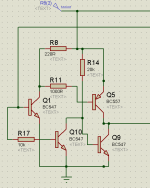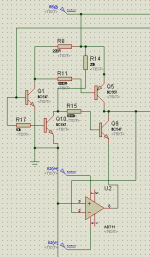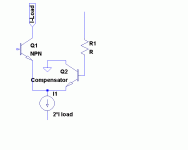Hello,
I am designing some circuit and I felt on a basic problem : I need a real 0V (read ground) after a BJT NPN used as a switch.
I did some search and found nothing revelent. Most pages says you can neglect it but in my use case, I can't.
How to overcome the VCE(sat) current leak and reach a real VCE = 0V ?
See attached picture of current design. Any tips welcome.
Regards,
Czk
I am designing some circuit and I felt on a basic problem : I need a real 0V (read ground) after a BJT NPN used as a switch.
I did some search and found nothing revelent. Most pages says you can neglect it but in my use case, I can't.
How to overcome the VCE(sat) current leak and reach a real VCE = 0V ?
See attached picture of current design. Any tips welcome.
Regards,
Czk
Attachments
As said above, jFETs or MOSfets have no saturation voltage; bjts always have some saturation voltage.
Tens of years ago, some bipolars were designed for chopper application and only had mV's of Vce under the rignt conditions, but they are not necessary anymore.
The best substitute you can find nowadays are low Vsat transistors: I just tested a ZTX849 in the sim, and it gives 3.9mV @1mA Ic and forced beta of 10. You won't get very much better than that.
If it's not enough, turn to the FEts, or use another similar transistor in series to cancel the voltage.
Tens of years ago, some bipolars were designed for chopper application and only had mV's of Vce under the rignt conditions, but they are not necessary anymore.
The best substitute you can find nowadays are low Vsat transistors: I just tested a ZTX849 in the sim, and it gives 3.9mV @1mA Ic and forced beta of 10. You won't get very much better than that.
If it's not enough, turn to the FEts, or use another similar transistor in series to cancel the voltage.
sawreyrw said:I agree, consider a MOSFET. A couple of questions. Why do you think you need 0 volts? At what current?
I am designing a DAC for educational purpose. The r2r ladder's bottom end is at ground. The Vce at saturation burry the LSB by a magnitude of 10 at least... (8mV Vce for 600uV LSB in simulation).
I think about applying a negative voltage at the emiter to correct the Vce at saturation. I uses an opamp in substraction mode. It worked nice in simulation : about 50uV. I guess it could be better with another opamp.
The opamp solution is a bit overkill to correct the Vce. Is there another way to solve this ?
Attachments
AndrewT said:why can't you consider a mechanical switch or even a relay?
Swith speed ?
48Khz for a mechanical swith or relay might be a bit ineffective.
- Status
- This old topic is closed. If you want to reopen this topic, contact a moderator using the "Report Post" button.
- Home
- General Interest
- Everything Else
- true VCE = 0V


